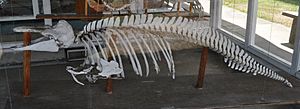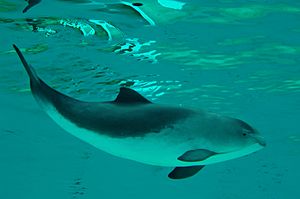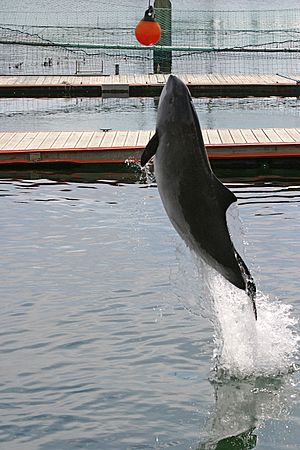Harbour porpoise facts for kids
Quick facts for kids Harbor porpoise |
|
|---|---|
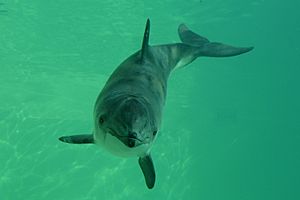 |
|
| Harbour porpoise in Ecomare, Netherlands | |
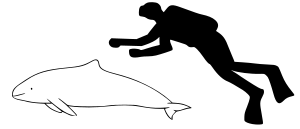 |
|
| Size compared to an average human | |
| Conservation status | |
| Scientific classification | |
| Genus: |
Phocoena
|
| Species: |
phocoena
|
| Subspecies | |
|
|
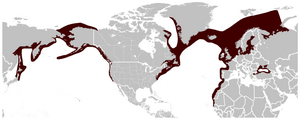 |
|
| Harbour porpoise range. | |
| Synonyms | |
|
Delphinus phocoena Linnaeus, 1758 |
|
The harbour porpoise (Phocoena phocoena) is one of the smallest marine mammals. It is one of seven types of porpoise. As its name suggests, it often stays near coastlines or river mouths. This makes it the most common porpoise seen by whale watchers. These porpoises can even travel far up rivers, sometimes hundreds of miles from the sea. There are different groups of harbour porpoises living in various parts of the world. These groups are found in the North Atlantic, West Africa, the Black Sea, the Sea of Azov, and the Pacific Ocean.
Contents
About the Harbour Porpoise Name
The word "porpoise" comes from an old French word meaning "sea pig." This name probably came from an even older Germanic word. In some places, like Atlantic Canada, people call it the "puffing pig." In Norway, it's called "nise," which comes from an old word for "sneeze." Both of these names refer to the sound the porpoise makes when it comes to the surface to breathe.
What Does a Harbour Porpoise Look Like?
The harbour porpoise is a bit smaller than other porpoises. When they are born, they are about 67 to 85 centimeters (26-33 inches) long. They weigh between 6.4 and 10 kilograms (14-22 pounds). Adult porpoises grow to be about 1.4 to 1.9 meters (4.6-6.2 feet) long. Females are usually heavier, weighing up to 76 kg (168 lb), while males weigh up to 61 kg (134 lb).
Their bodies are strong and thickest just before their triangular dorsal fin (the fin on their back). Their snout is not very noticeable. Their flippers, dorsal fin, tail fin, and back are dark grey. Their sides are a lighter, speckled grey. The underside of their body is much whiter, often with grey stripes on their throat.
Sometimes, harbour porpoises are born with unusual white coloring. This has been seen in the North Atlantic and near the coasts of Turkey and Britain. In 2017, fishermen in the North Sea found a very rare case of a two-headed harbour porpoise. This shows how unusual conjoined twins are in whales and dolphins.
Where Do Harbour Porpoises Live?
Harbour porpoises live in the cooler coastal waters of the North Atlantic, North Pacific, and the Black Sea. The groups in these areas are not connected and are considered different types. For example, P. p. phocoena lives in the North Atlantic and West Africa. P. p. relicta lives in the Black Sea and Sea of Azov. There are also groups in the northwest and northeast Pacific.
In the Atlantic, you can find them from West Africa up to the coasts of Europe, Iceland, Greenland, and North America. In the Baltic Sea, their numbers are lower in winter because the sea freezes. In the Pacific Ocean, they live from the Sea of Japan to Alaska and down to California.
How Many Harbour Porpoises Are There?
Globally, there are at least 700,000 harbour porpoises. A survey in 2016 found about 467,000 porpoises in the Atlantic region of Europe. This makes them one of the most common cetaceans (whales and dolphins) in that area. The population in this region seems to be stable. The most porpoises are found in the southwestern North Sea and near Denmark.
In the Western Atlantic, there are about 33,000 near Greenland and 75,000 between the Gulf of Maine and the Gulf of Saint Lawrence. The Pacific population off the United States is about 73,000, and off Alaska, it's 89,000. Some groups, however, are in danger. For example, there are fewer than 12,000 in the Black Sea and only about 500 left in the Baltic Sea.
Harbour Porpoise Natural History
Harbour Porpoise Ecology
Harbour porpoises like cool or mild waters. They live in fjords, bays, estuaries, and harbors, which is how they got their name. They mainly eat small schooling fish like herring, capelin, and sprat. Sometimes, they also eat squid and crustaceans. These porpoises often feed near the sea bottom, especially in waters less than 200 meters (656 feet) deep. However, when hunting sprat, they might stay closer to the surface.
A study in 2016 showed that porpoises off Denmark hunted 200 fish per hour during the day. At night, they hunted up to 550 fish per hour, catching 90% of their targets. Most of the fish they ate were very small, only 3 to 10 centimeters (1-4 inches) long. Young porpoises need to eat about 7% to 8% of their body weight each day to survive. This is about 7 kilograms (15 pounds) of fish.
Large predators like great white sharks and killer whales (orcas) hunt harbour porpoises. Researchers have also found that bottlenose dolphins sometimes attack and kill harbour porpoises. This might be due to competition for food or because the dolphins mistake the porpoises for young dolphins. Grey seals also attack porpoises, biting off chunks of fat for energy.
Harbour Porpoise Behaviour and Life Cycle
Harbour porpoises are generally seen as solitary animals. Most of the time, they are alone or in small groups of no more than five. They can dive up to 220 meters (720 feet) deep, and these dives can last up to five minutes, though they usually last about one minute.
Female porpoises can have babies every year once they are three or four years old. They can be pregnant and feeding a baby at the same time. Pregnancy usually lasts 10 to 11 months. Most births happen in late spring and summer. Baby porpoises drink their mother's milk for 8 to 12 months. Harbour porpoises usually live for 8 to 13 years, but some have lived up to 20 years.
Threats to Harbour Porpoises
Hunting
In the past, people hunted harbour porpoises for food and for their blubber (fat), which was used for lamp oil. This hunting happened in many places, including the Black Sea and off the coasts of Europe and North America. Today, they are not hunted for business, but they are still hunted for food in Greenland.
Fishing Gear Dangers
The biggest danger to porpoises comes from fishing nets, especially gill nets. Thousands of porpoises die each year by accidentally getting caught in these nets. This happens in the Black Sea, Baltic Sea, North Sea, and off the coasts of California, the United States, and Canada. Gill nets are anchored to the sea floor and can be very long.
Scientists are not sure why porpoises get tangled, as they can usually detect these nets using their echolocation (like sonar). Devices called "pingers" have been made to scare porpoises away from nets. These pingers work well, but some worry about the noise they add to the ocean and if porpoises might get used to the sound over time.
Too Much Fishing
When too many fish are caught (overfishing), there might not be enough food for porpoises. For example, when herring numbers dropped in the North Sea, porpoises had to find other food. This lack of food can be caused by overfishing, climate change, or both.
Noise Pollution
Loud noises from ships and oil platforms can affect porpoises. These animals use echolocation to communicate and find food, so loud noises can confuse them. Building offshore wind turbines also causes porpoises to leave the area, especially when loud hammering is used to put in the foundations. However, the noise from operating wind turbines is low and probably doesn't bother porpoises much.
Chemical Pollution
Porpoises, like other animals at the top of the food chain, can build up harmful chemicals in their fat. These chemicals include heavy metals and pesticides. Since porpoises live near coasts, they are often close to sources of pollution. These chemicals might not harm them until they use their fat reserves, like when they don't have enough food, are migrating, or having babies.
Climate Change
Rising sea temperatures could change where porpoises and their food live. For example, fewer sand eels off the coast of Scotland, linked to climate change, seem to be causing porpoises in that area to suffer from a lack of food.
Conservation Status
Overall, the harbour porpoise is not considered an endangered species, and there are hundreds of thousands of them. However, some groups are in serious trouble. The populations in the Baltic Sea and Western Africa are considered critically endangered. The Black Sea porpoise is also endangered.
Harbour porpoises are protected by several international agreements. These agreements aim to conserve small cetaceans in different parts of the world, like the Baltic, North, Irish, and Black Seas, and off the coast of West Africa.
Images for kids
See also
 In Spanish: Marsopa común para niños
In Spanish: Marsopa común para niños




